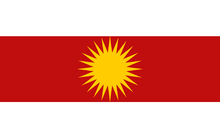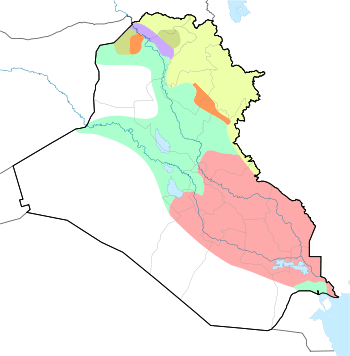Ezidkhan

Ezidkhan (or Êzîdxan, english translation: "Land of the Yazidis") is the historical area of settlement of the Yazidis.
Geography

The historical Ezidkhan area includes the Sinjar District (Sinjar town, Khana Sor, Sinune, Zorava, Gohbal, Borek, Dohula, Dugure, Siba Sheikh Khidir, Til Ezer, Kojo etc.) and Shekhan District (Shekhan town, Ba'adra, Lalish, Hahad etc.) and also parts of the Al-Hamdaniya District (Bashiqa and Bahzani) and Tel Keppe District (Hatarah,[1] Bozan etc.) in the Nineveh Governorate in northern Iraq.
Historical references
The term Ezidkhan is also often found in the sacred texts of the Yezidi. An example of this is the Qesîda Şerfedîn (The message of Sherfedin):[2][3]
- Ciwabê bidne Êzîdxanê (Proclaims the message in the Land of the Yezidis)
- Bila qayîmkin Îmanê (They should consolidate and defend their faith)
- Şerfedîn mîr e li dîwanê (Sherfedin is the prince in residence)
Notable historical locations
The village of Lalish, containing the holiest temple complex in Yezidism, is located within the Yezidi settlements in what is now northern Iraq. Lalish is currently under the jurisdiction of the Kurdistan Regional Government (KRG).
Modern usage
Due to the formation of dedicated Yezidi Peshmerga in response to the advance of the Islamic State of Iraq and the Levant, the term 'Ezidkhan' has experienced greater usage. In October 2015 the Yekîneyên Parastina Jin ê Şengalê or YPJ-Sinjar (Women's Defense Units of Sinjar) changed its name to Yekinêyen Jinên Êzidxan or YJÊ (Ezidkhan Women's Units).[4] And in November 2015 the Hêza Parastina Şingal or HPŞ (Protection Force of Sinjar) changed its name to Hêza Parastina Êzîdxanê or HPÊ (Protection Force of Ezidkhan).[5]
See also
References
- ↑ Università di Torino. Facoltà di lettere e filosofia; Centro ricerche archeologiche e scavi di Torino per il Medio Oriente e l'Asia (Italy); Centro scavi di Torino per il medio oriente e l'Asia (1997). Mesopotamia, Volume 32. Giappichelli.
- ↑ "ÊzîdîLeaks: Sheikh Sherfedin und seine militärischen Aktivitäten". Retrieved 16 January 2016.
- ↑ "Qesîda Şerfedîn – Die Botschaft Şerfedîns". Retrieved 16 January 2016.
- ↑ "ANF - Ajansa Nûçeyan a Firatê". Retrieved 16 January 2016.
- ↑ "HPŞ benennt sich in HPÊ um: Hêza Parastina Êzîdxan – ÊzîdîPress". Retrieved 16 January 2016.